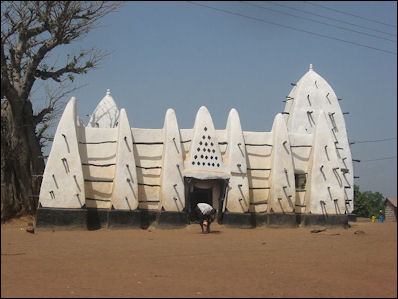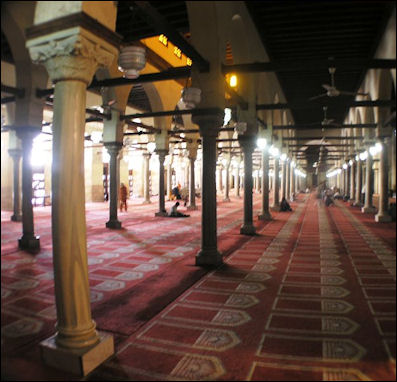Home | Category: Mosques, Mecca and Muslim Holy Places / Muslim Art and Architecture
MOSQUE ARCHITECTURE
Mosque in Ivory Coast Muslim architecture it expressed mostly in the form of mosques as well as in related “madrassahs” (theological schools), “khanqahs” (monasteries), shrines and mausoleum complexes.
Tim Stanley, curator the Middle Eastern collection a the Victoria & Albert Museum in London, told the Times of London, “What you must remember is that a mosque is built as much to honor its creator as to honor the creator of the universe. In its opulence and detail, it resembles a place as much as a church.” The concept behind a mosque is very simple. “All you need in a mosque is the correct orientation — toward Mecca and an open space.”
Mosques often lie at the center of a complex of buildings that can include related madrassahs khanqahs. shrines, mausoleum complexes, legal courts, hostels, hospitals, and facilities to help the poor. Turkish mosques were often built as part of larger complexes called “kulliye” that included a madrassah, a soup kitchen (“imaret”), public bath (“hamam”), and public fountain (“cesme” ) with drinking water. The building of mosques has traditionally been financed by donations obtained people and organizations living around the place where the mosque be built or a wealthy benefactor or foundation.
See Separate Article: MOSQUES: HISTORY, VERY OLD ONES, USES, MUEZZINS africame.factsanddetails.com
Websites and Resources: Islamic Architecture and Art: Islamic Arts & Architecture /web.archive.org ; Architecture of Islam ne.jp/asahi/arc ; Images of mosques all over the world, from the Aga Khan Documentation Center at MIT dome.mit.edu ; British Museum britishmuseum.org Islamic Art Metropolitan Museum of Art metmuseum.org/toah/hd/orna ; Islamic Art Louvre Louvre ; Museum without Frontiers museumwnf.org ; Victoria & Albert Museum vam.ac.uk ; Museum of Islamic Art, Doha, Qatar mia.org.qa ; CalligraphyIslamic, lots of Islamic calligraphy web.archive.org
RECOMMENDED BOOKS:
“Mosques: Splendors of Islam” by Leyla Uluhanli, Renata Holod, et al. Amazon.com ;
“Islamic Art: Architecture, Painting, Calligraphy, Ceramics, Glass, Carpets” by Luca Mozzati Amazon.com ;
“The Art and Architecture of Islam, 1250-1800" by Jonathan Bloom and Sheila S. Blair Amazon.com ;
“Islamic Art and Architecture, 650–1250" by Ettinghausen, Richard, Oleg Grabar, and Marilyn Jenkins-Madina (2001) Amazon.com ;
“Islamic Art and Architecture” by Robert Hillenbrand Amazon.com ;
“The Illustrated Encyclopedia of Islamic Art and Architecture (1,400 Years, 500 Color Images) by Moya Carey Amazon.com ;
“Mosque” by David Macaulay Amazon.com ;
“The Mosque: History, Architectural Development & Regional Diversity” by Martin Frishman and Hasan-Uddin Kha Amazon.com ;
“Mosque: Approaches to Art and Architecture” by Idries Trevathan Amazon.com ;
“The Holy Mosques of Makkah & Madinah” by Madiha Ali Amazon.com ;
“The Dome of the Rock” by Oleg Graba Amazon.com
“The Muslim’s Prayer” by Fahd Salem Bahammam Amazon.com ;
“How to Pray: A Step-by-Step Guide to Prayer in Islam” by Mustafa Umar Amazon.com ;
“Salat & Salam: In Praise of Allah's Most Beloved: A Manual of Blessings & Salutations on the Prophet” by Abdur-Rahman ibn Yusuf Amazon.com
Developments in Mosque Architecture
Because wood and stone were not very plentiful in the deserts and steppes in the Middle East, North Africa and Central Asia, where Islam grew up, brick became the desired building material. Building were traditionally designed to beat the heat, with lots of shade and large openings facing the wind. Fountains and pools an even streams were placed in courtyards to provide a cooling effect.
Central mosques and the squares in front of them were often placed in the center of cities and towns in the same way that cathedrals and market square were often situated at the center of European cities. Markets were often set up in the squares in front of mosques. Niiches in front walls of mosques were used by merchants.
Important advances in Muslim architecture included the development of fired bricks in the 10th century, colored tilework in the 12th century, polychrome tile in the 14th century, and the squinch (a kind or bracketing used in making large domes).
Mosque construction provided lot of work for artists, craftsmen and tilemakers. Whereas cathedrals were often built to impress with their size and scale, mosques were often built to impress with their details.
Mosque Features

main parts of a mosque
Mosques are generally built around open courtyards, off of which are one or more “iwan” (prayer halls). The iwan facing Mecca is the main prayer hall, or “mihrab” apse, where the imam leads the faithful in prayer. Often, in the courtyard or in front of a mosque are pools, where the faithful wash before entering the mosque. The main doorway is oriented in the direction of Mecca. Most mosques have a “qibla” (a marking the showed the direction of Mecca).
There are two main styles of mosque architecture: 1) hypostyle, in which the roof is supported on pillars: and 2) domical, where the walls are surrounded by a dome. There are few hypostyle mosques and they tend to be old or very basic. Mosques are focused on their large central prayer room and lack the processional and ceremonial spaces found in cathedrals.
Most mosques feature a single chamber entered through doors topped with cusped arches. Above the chamber is a dome. The idea of a mosque is to create as much space as possible for the uninterrupted communion between worshipers and God. For many Muslims, the dome symbolizes oneness with God. The main dome is usually above the “mihrab” apse. Some mosques feature dozens of domes.
Dr. Carool Kersten of Kings College London wrote for the BBC: “The prayer hall, also known as the "musallah", is a large open space, where everyone sits on the floor. Mosques were designed to house the entire male population of a city or town. Women can attend Friday prayers, but are not required to do so. Women are traditionally segregated from men by tradition rules and pray in a separate space or chamber. [Source: Dr. Carool Kersten, Kings College London, BBC |::|]
“A "mihrab" is a semicircular niche in the wall of a mosque that indicates the direction of Mecca. The direction towards Mecca is known as the "qibla". Mecca is the city where the Prophet Muhammad was born and is the site of Islam’s holiest mosque, Masjid al-Haram. Next to the "mihrab" there is a "minbar". This is a pulpit from where an imam or khatib delivers a sermon. |::|
“Ablutions area: Before prayer, Muslims perform ritual washing, or “wudu”, in the ablutions area. Larger mosques have an ablutions fountain in their entryways or courtyards. In smaller mosques the restrooms may be used for ablutions. |::|
Mosque Domes
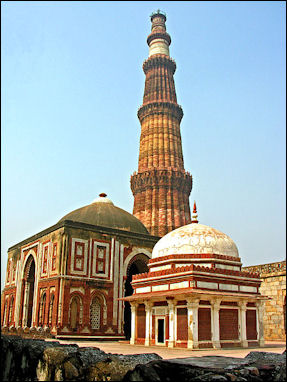
Alai Gate and Qutub Minaret Domes are central to mosque architecture. Dr. Carool Kersten of Kings College London wrote for he BBC: “The dome, or "qubba", is often placed directly above the main prayer hall as a symbol of both the vaults of heaven and the sky. Early mosques had a small dome taking up part of the roof near the mihrab. As time passed, bigger domes were built, some of which encompassed the entire roof above the prayer hall. [Source: Dr. Carool Kersten, Kings College London, BBC |::|]
For many Muslims, the dome symbolizes oneness with God. The main dome is usually above the mihrab apse. Some mosques feature dozens of domes. They can be decorated both inside and outside with a variety of geometric shapes and other designs. The placement of a round dome on a square hall is a achieved with the help of a squinch or pendentive, sometimes with man-made stalactites for decorations.
One of the greatest challenges of building a mosque is constructing the circular dome over the square prayer hall. The hemispherical shape of the dome creates hidden forces that try to push the sides outward. Arches and piers are designed not only to support the dome but also reduce the outward stress on the walls. Supports generally have to be built on the outside of the walls to push them in.
Minarets
Minarets are the tall, slender towers outside a mosque. They typically have a balcony at the top used by the muezzin to call the faithful to prayer. Some are purely ornamental. In the old days the muezzins climbed the stairs inside the minaret to the calling area. In famous mosques tourists are sometimes are allowed to climb the stairs. The word "minaret" comes from the Arabic "manarah", which means lighthouse.
Minarets are the tallest parts of a mosque. The highest minaret in the world is located at the Hassan II Mosque in Casablanca, Morocco. Minarets symbolize both the supremacy and the oneness of God. To some Muslims they represent the Arabic letter alif , the first letter in Allah's name. Minarets are typically made of brick, and sometimes covered with tiles. The name of Allah and invocations to God are typically written in Arabic calligraphy at the top.
Most mosques have at least one minaret. Some have only one. Many have four, one on each corner of the mosque ground. None are supposed to have seven because only the Great Mosque of Mecca is allowed to have that number. The place the muezzin traditionally stands on a minaret is built without scaffolding until reaching the height of the balcony — which bulges outward from the rest of the structure. The tower and the stairs are often built together with the builders simply building the structure upwards as they go.
Mosque Interior
Al-Azhar Mosque prayer hall, Cairo The inside of a mosque is surprisingly empty and generally pretty austere. There are no seats, little furniture and often few decorations. Worshipers tend to sit and pray on the floor facing the mihrab that indicates the qibla (direction) of Mecca. Chairs or benches would only get in the way of the praying, prostrating and standing up.
The floors are often covered in carpets. There are few internal walls. This is because the mosque is designed for single space worship of a given Muslim community. A screen in a mosque provided privacy for important people or women. There is special stand that hold the Qur’an.
The “mihrab “ is a small alcove-like niche, which marks the direction of Mecca and the entry point to paradise. It is often empty, which symbolizes the simple perfection of Allah. Decorations around it on the qibla wall are intended to focus attention on its simplicity. Many mosques are designed so that the maximum number of people can see the mihrab. The arched shape of the mihrab is one of the few permitted Islamic motifs. It is often seen on prayers rugs and decorative wall tiles. Some tiled mihrabs are regarded as among the finest works of Islamic art.
Describing the interior of a great mosque in Cairo, Michael Glover wrote in the Times of London, “There are wonderful hanging lamps and marble revetments, I drag my finger through the thick coating of dust that has settled... We are unaccustomed to buildings that are so open to the blue of the sky. Birds flit in and out of the great inner courtyard, dipping into and out of the ablution fountains that stand at its center.”
Minbars
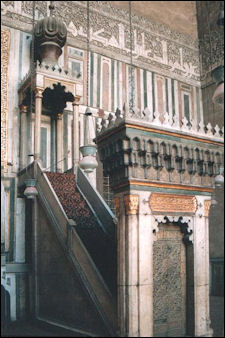
Minbar at Sultan Hassan mosque The minbar is raised platform in mosque — a pulpit. Near the mihrab is a stepped pulpit called the “minbar” (also minber). This is where the imam or khatib gives his Friday sermon. It is often ornately decorated and the only real structure in a mosque. The preacher usually speaks from a step below the minibar platform because the platform is reserved for the Prophet and Caliphs who occupy a higher position. Below the minibar steps is a small door concealed by a curtain. No one but the imam is supposed to enter this door.
Many minbars are portable pulpits that look like decorative wooden staircases on wheels. They are kept in closets most of the time and are wheeled out for Friday sermons. Some minbars are also exquisite examples of Islamic art, ornately decorated with carved geometric patterns and inlayed with ivory and precious woods.”
Describing a minbar in a great mosque in Cairo, Michael Glover wrote in the Times of London, “We approach the great “minbar”, the wooden pulpit with double doors and steep steps up which the imam ascends to lead Friday prayers. It is adorned with the most exquisite ivory panels: extraordinarily delicate wheels and trapezoidal shapes...The extraordinary thing about a minbar such as this one is that it’s a bit like a flatpack from Ikea in certain respects. It would have been constructed to be use in a mosque such as this one, but you could take it apart and erect it elsewhere.”
Mosque Decoration
In keeping with the Muslim prohibition on representations of animals and people, the tiles, walls and arches were decorated with calligraphy, mosaics, floral designs and geometric shapes. The calligraphy is often either in the stylized kufic script favored the Timurid or the often foliated “thulth” scripts.
Many mosques and Islamic buildings are famous for their colorful tilework. They not only make the building look beautiful they also make them appear lighter. The tiles are se up to reflect the desert sun. Ones that are deep cobalt blue or turquoise (meaning "color of the Turks") are often featured in domes.
The tiles come in variety of styles: stamped, chromatic (one color painted on and then fired), polychromatic (several colors painted on and then fired), and faience (carved onto wet clay and then fired). Other decorative features include carved and painted woodwork. patterned brickwork, colored marble and stucco, and carved “ghanch” (alabaster).
Other Islamic Buildings
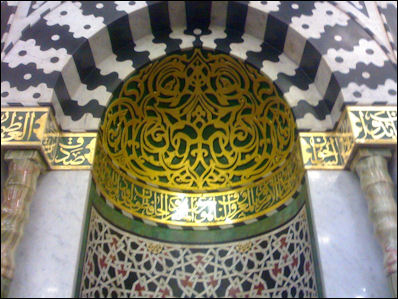
Prophet Mohammad Mihrab Many of the most famous Islamic buildings are madrassahs (madrasahs), Islamic theological schools. They typically are two stores high and have a central courtyard surrounded by cell-like living quarters (“hujras” ) used by students, teachers and traveling scholars.
In pre-Islamic days and the early Islamic period, shrines were built around pilgrimage sites and places of special importance such as the Kaaba, the place where Abraham almost sacrificed Ishmail (the Dome of the Rock) and the tomb of Abraham in Hebron. Later these and the tombs of important Muslim figures became shrines. Mausoleums and shrines are particularly important to Shiites. Most have a prayer room set under a domed cupola. The actual tombs may be located in a central hall or underground in a crypt-like room. Some have accommodation, washrooms and kitchens.
Image Sources: Wikimedia Commons
Text Sources: “World Religions” edited by Geoffrey Parrinder (Facts on File Publications, New York); “Encyclopedia of the World’s Religions” edited by R.C. Zaehner (Barnes & Noble Books, 1959); Arab News, Jeddah; “Islam, a Short History” by Karen Armstrong; “A History of the Arab Peoples” by Albert Hourani (Faber and Faber, 1991); “Encyclopedia of the World Cultures” edited by David Levinson (G.K. Hall & Company, New York, 1994). Also articles in National Geographic, the New York Times, Washington Post, Los Angeles Times, Smithsonian magazine, Times of London, The New Yorker, Time, Newsweek, Reuters, AP, AFP, Lonely Planet Guides, Compton’s Encyclopedia and various books and other publications.
Last updated March 2024

